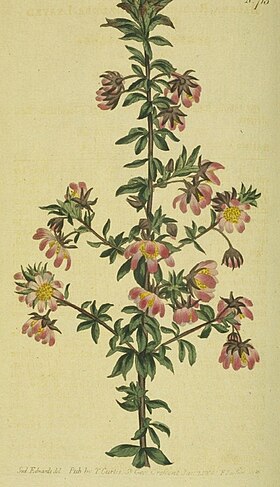Curtis's Botanical Magazine/Volume 19/715 Bauera rubioides
[ 715 ]
Bauera rubioides. Madder-Leaved
Bauera.
***************
Class and Order.
Icosandia Digynia.
Generic Character.
Cal. inferus 8-sidus. Cor. 8-petala. Caps. 2-locularis. Sem.
plurima.
Specific Character and Synonyms.
BAUERA rubioides. And. Bot. Repos. t. 198

Desc. Stalk shrubby, 3-6 feet high, branched. Branches
opposite, patent, rigid. Leaves ternate, opposite; giving the
appearance at first sight of six leaves growing in a whorl:
Leaflets lanceolate, serrate, rugose-veined, naked. Peduncles
axillary, longer than the leaves, at first erect, afterwards fre-
quently drooping. Calyx inferior, one-leafed and growing to
the germen, deeply divided into eight slightly toothed, lanceo-
late segments, reflexed, persistent. Corolla, rose-coloured,
eight petaled, but one is deficient; Petals lanceolate,
concave, patent, quite entire. Filaments many, shorter than
petals, attached to the inside of the calyx, not to the receptacle,
wherefore this plant belongs to the class Icosandria, not to
Polyandria, where it is referred in the Botanists Repository.
Anthers yellow, roundish. Germen roundish, somewhat flat-
tened, emarginate. Styles two, filiform, divergent. Stigmas
acute.
A handsome flowering shrub, without scent. Taste of the
leaves bitterish, subastringent, not unlike Chinese Tea
This plant, a native of New-Holland, received the above
name in honour of the two Bauers, natives of Germany,
both very eminent botanical draughtsmen in the employ of this
country; the elder brother at the Royal Garden at Kew, the
younger now on a voyage of discovery in the South-Sea. The
trivial name is derived from the resemblance which it bears,
especially in its young state, to a Rubia, not a Rubus, as
Mr. Andrews, with his usual accuracy, would have it. Flowers
through the greatest part of the Summer.
Our Drawing was taken at Messrs. Grimwood and Wykes's,
Kensington, where, we are informed, it was first raised in this
country. It may be increased by cuttings.